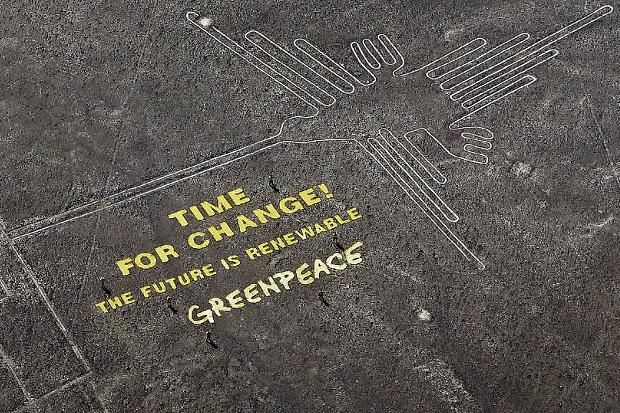Greenpeace tred on the wrong toes at Nazca
[dropcap]H[/dropcap]ow far should people go to get a message across? This is a question that Greenpeace will be asking as they find themselves in serious trouble with the Peruvian authorities.
On Monday, around a dozen Greenpeace activists arrived on the Nazca lines in the Peruvian desert to unfurl a large message; ‘Time for change! The future is renewable. Greenpeace’. The problem? The sacred site, consisting of 100’s of kilometres of 1500 year old geoglyphs, are a forbidden area to even the most important officials; any who access the lines must have exceptional permission and special footwear to avoid damage.
These were precautions that Greenpeace did not take. In the process of their publicity stunt they damaged the lines, and their context, deeply offending what amounts to an entire country. The area surrounding one of the most famous images, that of the hummingbird, was most likely irreversibly damaged; and the problem with the millennia old site is they are essentially footprints in the earth that have been left their for thousands of years. Thus, so will the carvings of Greenpeace.
Now the Peruvian authorities are seeking to prosecute the activists for the damage of the archaeological site, a prosecution which could lead to up to six years in jail for the 12 or so activists. This is not excessive or corrupt, as some are claiming. Some believe that the act was justified; the message that Greenpeace are spreading here is important. But in this case, the ends do not justify the means.
The lines constitute one of the most sacred sites of an entire country; for Greenpeace to damage them are an insult and an outrage.
As Greenpeace’s own apology states, the stunt was without doubt ‘careless and crass’. The lines constitute one of the most sacred sites of an entire country; for Greenpeace to damage them are an insult and an outrage. Some have defended these actions; they have pointed out that the Nazca people no longer exist, that the message is important, that the lines are just that, mere ditches in a desert.
These pseudo-intellectual arguments are outbursts built on outrage and indignation; they only present that these apologists have little to no understanding of the culture and heritage behind neither the sites themselves, nor the objections to their destruction. The people who built them no longer exist in any real sense. But that does not detract from the value of their monuments; why should the lines be any different? Further, if you think the lines to be primitive, as some are claiming as an excuse, remind yourselves that our national monument is a pile of stones. The activists must face justice, and Greenpeace must pay recompense.
The organisation is already deliberately evading the help they promised the authorities by not passing on the names of the Peruvian activists to the police. Evidently, they believe their opinions are vastly more important than a country’s beliefs, values, and culture. It is true; the world does need to change, and further, Greenpeace’s message is important. They are right; ‘Time for change! The future is renewable. Greenpeace’. But unfortunately, 1500 year old geoglyphs are not quite as renewable.
[divider]
Header Photo: flickr / greenpeacepl
Body Photo: http://bemoxie.org/wp-content/uploads/2014/12/Greenpeace-Nazca_Reuters.jpg


Comments (1)
Brilliant article, unusually there is no criticism I have to make.